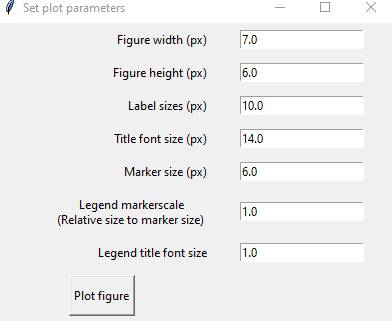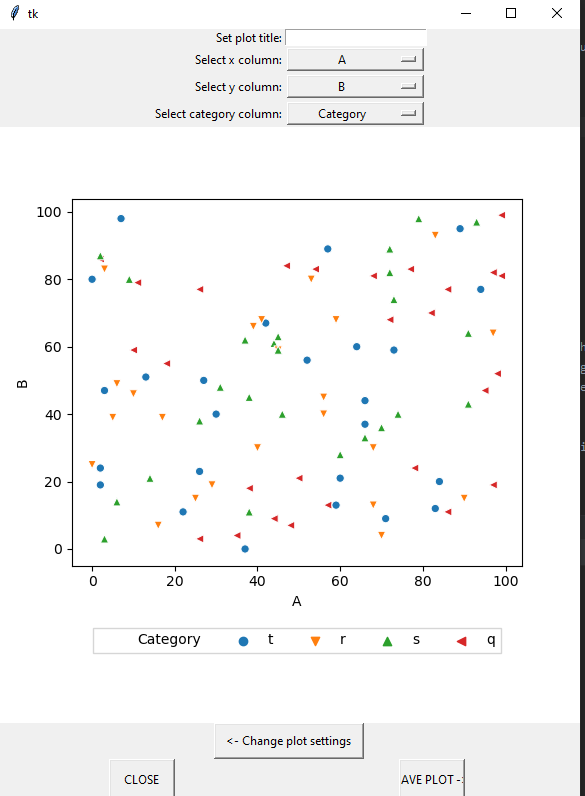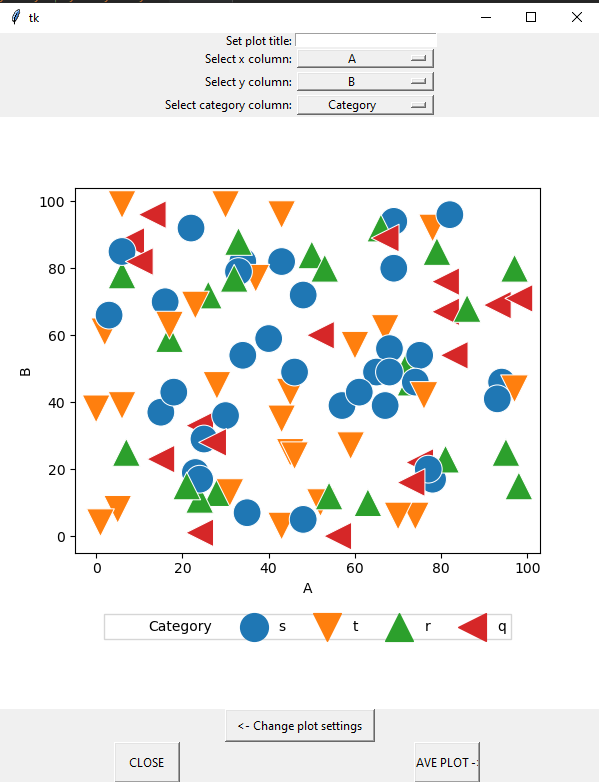I am working on an interactive plotting script using matplotlib version 3.2.2 and tkinter.
When the script is run, the first window looks like this:
 Furthermore, the rcParams are updated and plotted once the Plot figure button is clicked:
Furthermore, the rcParams are updated and plotted once the Plot figure button is clicked:
If I now hit the button Change plot settings and change for instance the markersize parameter -> Plot figure, the plot is updated like so:
if I, however, try changing the label sizes to 20 px and then validate that the rcParams['axes.labelsize'] is changed, they are. But the size of the x and y labels are never updated in the actual plot.
The plot title (text input field all the way to the top in the plot window) fontsize can be changed after it has been plotted.
The minimal code:
"""
This is a script for interactively plotting a scatterplot and changing the plot params.
"""
import numpy as np
import matplotlib as mpl
import matplotlib.style
import random
mpl.use('TkAgg')
import numpy as np
from matplotlib.backends.backend_tkagg import FigureCanvasTkAgg
from matplotlib.figure import Figure
from tkinter import *
import matplotlib.pyplot as plt
import pandas as pd
import seaborn as sns
from pandas.api.types import is_numeric_dtype
def center_tk_window(window, height, width):
# Helper method for centering windows
screen_width = window.winfo_screenwidth()
screen_height = window.winfo_screenheight()
x_coordinate = int((screen_width / 2) - (width / 2))
y_coordinate = int((screen_height / 2) - (height / 2))
window.geometry("{}x{}+{}+{}".format(width, height, x_coordinate, y_coordinate))
def plot_data(data, chosen_columns, ax=None, initial_box=None, fig=None):
if fig is None:
fig = Figure()
if ax is None:
# Create a new subplot
ax = fig.add_subplot(111)
# Selected x-coordinates
x_data = data[chosen_columns['x_col']]
# Selected y-coordinates
if 'y_col' in chosen_columns:
y_data = data[chosen_columns['y_col']]
filled_markers = ('o', 'v', '^', '<', '>', '8', 's', 'p', '*', 'h', 'H', 'D', 'd', 'P', 'X')
# Category column
if 'category_col' in chosen_columns:
category_data = data[chosen_columns['category_col']]
# Plotting it all
sns.scatterplot(ax=ax, x=x_data, y=y_data, hue=category_data, style=category_data,
markers=filled_markers
)
# Shrink current axis's height by 20% on the bottom
if initial_box is None:
initial_box = ax.get_position()
ax.set_position([initial_box.x0, initial_box.y0 + initial_box.height * 0.2,
initial_box.width, initial_box.height * 0.80])
# Put a legend below current axis
ax.legend(bbox_to_anchor=(0.5, -0.15), ncol=6)
else: # Normal scatterplot without any categorical values
sns.scatterplot(ax=ax, x=x_data, y=y_data)
ax.set_ylabel(chosen_columns['y_col'])
ax.set_xlabel(chosen_columns['x_col'])
return fig, ax, initial_box
class GenericPlot:
def __init__(self, data):
# Parameters window selection
self.canvas = None
self.fig = None
self.ax = None
self.chosen_columns = None
self.initial_box = None
self.updated_rc_params = None
self.set_plot_params(data)
# Plot window
self.save_plot_bool = False
self.plot_window = Tk()
self.interactive_plot(data)
self.plot_window.mainloop()
def set_plot_params(self, data):
def plot_with_settings():
def format_input(input):
if input == '':
# Use the default value
return mpl.rcParams[input]
if ',' in input:
return float(input.replace(',', '.'))
else:
return float(input)
# Figure size
figure_params = {}
if figsize_width.get() != '' and figsize_height.get() != '':
figure_params['figsize'] = (format_input(figsize_width.get()), format_input(figsize_height.get()))
# label sizes
axes_params = {}
if label_size.get() != '':
axes_params['labelsize'] = format_input(label_size.get())
if title_size.get() != '':
axes_params['titlesize'] = format_input(title_size.get())
legend_params = {}
if legend_title_fontsize.get() != '': legend_params['title_fontsize'] = format_input(
legend_title_fontsize.get())
legend_additional = {'loc': 'upper center',
'fancybox': False,
'shadow': False
}
legend_params.update(legend_additional)
if marker_size.get() != '': lines_params = {'markersize': format_input(marker_size.get())}
legend_params['markerscale'] = format_input(legend_markerscale.get())
mpl.rc('figure', **figure_params)
mpl.rc('axes', **axes_params)
mpl.rc('lines', **lines_params)
mpl.rc('legend', **legend_params)
self.updated_rc_params = mpl.rcParams
# Update canvas if the params were changed after it was drawn:
if self.ax is not None:
self.ax.clear()
mpl.rcParams.update(self.updated_rc_params)
self.fig, self.ax, _ = plot_data(data, self.chosen_columns, self.ax,
self.initial_box, self.fig)
self.canvas.draw()
custom_params_window.destroy() # Close the tk window
# Create a new window
custom_params_window = Tk()
center_tk_window(custom_params_window, 300, 400) # window, height, width
custom_params_window.title('Set plot parameters')
# Set up GUI
custom_params_window.columnconfigure(0, weight=1)
custom_params_window.columnconfigure(1, weight=1)
n_rows = 8
for r in range(n_rows):
custom_params_window.rowconfigure(r, weight=1)
row_num = 0
# Figsize
Label(custom_params_window, text="Figure width (px)").grid(row=row_num, column=0, sticky="e")
figsize_width = Entry(custom_params_window)
placeholder_width = self.updated_rc_params['figure.figsize'][
0] if self.updated_rc_params is not None else 7.0
figsize_width.insert(0, placeholder_width)
figsize_width.grid(row=row_num, column=1)
row_num += 1
Label(custom_params_window, text="Figure height (px)").grid(row=row_num, column=0, sticky="e")
figsize_height = Entry(custom_params_window)
placeholder_height = self.updated_rc_params['figure.figsize'][
1] if self.updated_rc_params is not None else 6.0
figsize_height.insert(0, placeholder_height)
figsize_height.grid(row=row_num, column=1)
# User input label size
row_num += 1
Label(custom_params_window, text="Label sizes (px)").grid(row=row_num, column=0, sticky="e")
label_size = Entry(custom_params_window)
placeholder_label_size = self.updated_rc_params[
'axes.labelsize'] if self.updated_rc_params is not None else 10.0
label_size.insert(0, placeholder_label_size)
label_size.grid(row=row_num, column=1)
# User input title size
row_num += 1
Label(custom_params_window, text="Title font size (px)").grid(row=row_num, column=0, sticky="e")
title_size = Entry(custom_params_window)
placeholder_axes_titlesize = self.updated_rc_params[
'axes.titlesize'] if self.updated_rc_params is not None else 14.0
title_size.insert(0, placeholder_axes_titlesize)
title_size.grid(row=row_num, column=1)
print(" self.updated_rc_params STATUS:", self.updated_rc_params)
# Marker_size
row_num += 1
Label(custom_params_window, text="Marker size (px)").grid(row=row_num, column=0, sticky="e")
marker_size = Entry(custom_params_window)
placeholder_legend_markersize = self.updated_rc_params[
'lines.markersize'] if self.updated_rc_params is not None else 6.0
marker_size.insert(0, placeholder_legend_markersize)
marker_size.grid(row=row_num, column=1)
# Legend markerscale
row_num += 1
Label(custom_params_window, text="Legend markerscale\n(Relative size to marker size) ").grid(
row=row_num, column=0,
sticky="e")
legend_markerscale = Entry(custom_params_window)
placeholder_legend_markerscale = self.updated_rc_params[
'legend.markerscale'] if self.updated_rc_params is not None else 1.0
legend_markerscale.insert(0, placeholder_legend_markerscale)
legend_markerscale.grid(row=row_num, column=1)
# Legend title size
row_num += 1
Label(custom_params_window, text="Legend title font size").grid(row=row_num, column=0, sticky="e")
legend_title_fontsize = Entry(custom_params_window)
placeholder_legend_title_size = self.updated_rc_params[
'legend.title_fontsize'] if self.updated_rc_params is not None else 1.0
legend_title_fontsize.insert(0, placeholder_legend_title_size)
legend_title_fontsize.grid(row=row_num, column=1)
row_num += 1
Button(custom_params_window, text="Plot figure", command=lambda: plot_with_settings(), height=2,
width=8).grid(row=row_num, column=0)
custom_params_window.mainloop()
def interactive_plot(self, data):
"""
Input :
window : tkinter window
data : DataFrame object
"""
def close_plot_window():
self.plot_window.destroy()
def set_save_plot_bool():
self.save_plot_bool = True
self.plot_window.destroy()
center_tk_window(self.plot_window, 750, 600)
# Drop-down variables (3 drop-downs)
dropdown_choice_x = StringVar(self.plot_window) # Variable holding the dropdown selection for the x column
dropdown_choice_y = StringVar(self.plot_window) # Variable holding the dropdown selection for the y column
dropdown_choice_category = StringVar(
self.plot_window) # Variable holding the dropdown selection for the category column
# Create set of column names in the dataset
choices = data.columns.values
# Find numeric and string columns
string_columns = []
numeric_columns = []
[numeric_columns.append(col) if is_numeric_dtype(data[col]) else string_columns.append(col) for col in
data.columns]
if len(numeric_columns) < 1:
raise Exception("Unable to plot, there are too few numerical columns.")
if len(numeric_columns) == 1:
raise Exception(
"Unable to create scatter plot- need more than two numerical columns in the imported dataset.")
# GUI setup
self.plot_window.columnconfigure(0, weight=1)
self.plot_window.columnconfigure(1, weight=1)
n_rows = 6
for r in range(n_rows):
self.plot_window.rowconfigure(r, weight=1)
def update_ax_title(title):
self.ax.set_title(title.get())
self.canvas.draw()
title = StringVar()
title.trace("w", lambda name, index, mode, title=title: update_ax_title(title))
# Set title
Label(self.plot_window, text="Set plot title:").grid(row=0, column=0, sticky="e")
e = Entry(self.plot_window, textvariable=title, width=23)
e.grid(row=0, column=1, sticky="w")
# Drop-down 1: x-value selection
if len(numeric_columns) >= 1:
x_values_column = numeric_columns[0] # Select the first numeric column as the default x values to plot
dropdown_choice_x.set(x_values_column) # Set the default option in the dropdown with the first column
Label(self.plot_window, text="Select x column:").grid(row=1, column=0, sticky="e")
choices_numeric = numeric_columns # Only show numeric columns in the drop-down for x and y
dropdown_menu_x = OptionMenu(self.plot_window, dropdown_choice_x, *choices_numeric)
dropdown_menu_x.grid(row=1, column=1, sticky="w")
dropdown_menu_x.config(width=16)
self.chosen_columns = {'x_col': x_values_column}
# Drop-down 2: y-value selection
if len(numeric_columns) >= 2:
y_values_column = numeric_columns[1] # Select the second alternative in the dropdown list for the y values
dropdown_choice_y.set(y_values_column) # Set the default option in the dropdown with the first column
l2 = Label(self.plot_window, text="Select y column:")
l2.grid(row=2, column=0, sticky='e')
dropdown_menu_y = OptionMenu(self.plot_window, dropdown_choice_y, *choices_numeric)
dropdown_menu_y.config(width=16)
dropdown_menu_y.grid(row=2, column=1, sticky='w')
self.chosen_columns = {'x_col': x_values_column,
'y_col': y_values_column}
if len(data.columns) > 2: # There exist a third columns as well -> include drop-down for category selection
# Drop-down 3: Category selections
category_column = string_columns[0] if (len(string_columns) > 0) else numeric_columns[2]
dropdown_choice_category.set(
category_column) # Set the default option in the dropdown with the first column
l3 = Label(self.plot_window, text="Select category column:")
l3.grid(row=3, column=0, sticky='e')
dropdown_menu_category = OptionMenu(self.plot_window, dropdown_choice_category, *choices, 'Set title above')
dropdown_menu_category.config(width=16)
dropdown_menu_category.grid(row=3, column=1, sticky='w')
self.chosen_columns = {'x_col': x_values_column,
'y_col': y_values_column,
'category_col': category_column}
# Plot the initially selected columns
self.fig, self.ax, self.initial_box = plot_data(data, self.chosen_columns)
self.canvas = FigureCanvasTkAgg(self.fig, master=self.plot_window)
self.canvas.get_tk_widget().grid(row=4, columnspan=2, rowspan=True)
self.canvas.draw()
def change_dropdown_x(*args):
# This function is triggered once a dropdown selection is made
selected_x_col = dropdown_choice_x.get()
self.chosen_columns['x_col'] = selected_x_col
# Create a new plot now
self.ax.clear() # Clearing the previous plot
self.fig, self.ax, _ = plot_data(data, self.chosen_columns, self.ax, self.initial_box,
self.fig)
self.canvas.draw()
# chosen columns might not be updated...
def change_dropdown_y(*args):
# This function is triggered once a dropdown selection is made
selected_y_col = dropdown_choice_y.get()
self.chosen_columns['y_col'] = selected_y_col
# Create a new plot now
self.ax.clear() # Clearing the previous plot
self.fig, self.ax, _ = plot_data(data, self.chosen_columns, self.ax, self.initial_box,
self.fig)
self.canvas.draw()
def change_dropdown_category(*args):
# This function is triggered once a dropdown selection is made
selected_category = dropdown_choice_category.get()
self.chosen_columns['category_col'] = selected_category
# Create a new plot now
self.ax.clear() # Clearing the previous plot
self.fig, self.ax, _ = plot_data(data, self.chosen_columns, self.ax, self.initial_box,
self.fig)
self.canvas.draw()
# Link functions to change dropdown
dropdown_choice_x.trace('w',
lambda *args: change_dropdown_x(
*args))
dropdown_choice_y.trace('w',
lambda *args: change_dropdown_y(
*args))
dropdown_choice_category.trace('w', lambda *args: change_dropdown_category(
*args))
def change_settings():
self.plot_params_type = 'customize'
self.set_plot_params(data)
# self.plot_window.destroy()
# Save and close buttons
Button(self.plot_window, text="<- Change plot settings", command=change_settings, height=2, width=20).grid(
row=5, columnspan=2)
Button(self.plot_window, text="CLOSE", command=close_plot_window, height=2, width=8).grid(row=6, column=0)
Button(self.plot_window, text="SAVE PLOT ->", command=set_save_plot_bool, height=2, width=8).grid(row=6,
column=1)
# Create dummy data to plot
df = pd.DataFrame(np.random.randint(0, 100, size=(100, 4)), columns=list('ABCD'))
# Add a category column to the DataFrame
labels = ['q', 'r', 's', 't']
df['Category'] = [labels[random.randint(0, len(labels) - 1)] for i in range(100)]
GenericPlot(df)
I have tried to change the x and y label sizes in the function called update_ax_title (just to debug:
And run the function
def update_ax_title(title):
self.ax.set_title(title.get()) # Correct size (5.0)
self.ax.set_xlabel('gdsgsdgsdgsdgdsg') # Incorrect size...
print(mpl.rcParams['axes.labelsize']) # prints 5.0
print(mpl.rcParams['axes.titlesize']) # prints 5.0
self.canvas.draw()
Only the title size is updated, even though the rcParams are updated globally. The x and y label sizes change after running specifically self.ax.set_xlabel('gdsgsdgsdgsdgdsg',fontsize=5)
How can this issue be solved? Thanks!


